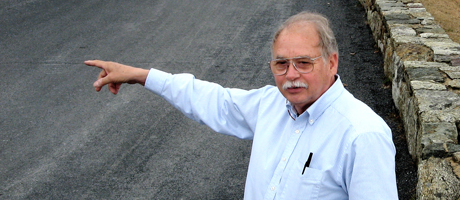George Stephens, GW professor of geography and geosciences, died on Nov. 2. Professor Stephens was also a GW alumnus with bachelor’s and master’s degrees in geology from the University. He joined the GW faculty as assistant professor of geology in 1978, after holding teaching positions at Bryn Mawr and LaSalle colleges.
“Professor Stephens served in many capacities during his long tenure here, and he was regarded by students and colleagues alike as a caring and dedicated teacher and mentor,” says Columbian College of Arts and Sciences Dean Peg Barratt. “His students admired Professor Stephens’ unbridled passion for geology as they trekked with him over the terrain that formed the laboratory for his classes.”
Professor Stephens also served as deputy director of the University Honors Program. “His commitment to the honors program was genuine, and he cared deeply about his students,” says Maria Frawley, director of the program. “He was a valued and much beloved colleague who will be sorely missed.”
The flags in front of Rice Hall were lowered in Professor Stephens’ honor on Nov. 5.
A memorial service for Professor Stephens was held Nov. 7 at 2 p.m. at Mt. Olivet United Methodist Church, 1500 N. Glebe Rd., Arlington, Va. In lieu of flowers, contributions may be made to GW’s Geology Program in Professor Stephens’ name.
Richard Tollo, associate professor of geosciences at GW and longtime colleague of George Stephens, wrote the following tribute:
George was a teacher who cared deeply about his students. Academically rigorous but with an obvious concern for the individual needs of every student, George was revered by students who grew accustomed to his folksy stories and the obvious delight he took from studying the natural world and explaining relationships to his classes. His personal warmth and sincere demeanor earned him genuine affection and respect from his classes year after year. Nearly every fall when he taught his course in structural geology, he would find a student or two who enrolled in the course not for the subject matter but simply to relish the experience of being taught by such a kindhearted and sincere instructor. Typically, George would shepherd them along with personal attention and make sure that their academic experience was both positive and enriching.
George was an accomplished, field-based geologist with a wide range of scientific interests. His primary specialization was structural geology, a field in which he made important and long-lasting contributions through his studies of deformation mechanisms in complexly folded and faulted Ordovician strata in Pennsylvania. Several decades later, his work is still routinely referenced in the scientific literature as the starting point for any similar studies, which is a rarity in the present era of fast-paced, quickly-improved-upon scientific investigations. George’s interests led him to undertake many other types of research that allowed him to apply his ample geological skills. Among these are studies of glacial deposits in Spitsbergen and at the Sterling mine in New Jersey, a location famous around the world for its fluorescent minerals.
In recent years, he collaborated on forensic studies, continually breaking new ground by applying his knowledge of geological materials and techniques to assist in a wide range of forensic studies. Throughout his career, however, George resisted the ultra specialization expected of contemporary scientists, opting instead for using his nearly limitless curiosity as a guide toward taking on the problems that his constantly inquisitive nature uncovered.
George’s wide interests also led him to forge a broad range of experiences while teaching at GW. He managed a scientific program at the National Science Foundation and, in addition, served as a technical reviewer and member of scientific review panels. He created curriculum and taught hands-on exercises and field trips for science teachers from the District of Columbia system. He was part of the first wave of faculty who recognized the importance of the Mount Vernon Campus to the intellectual pulse of the University and taught courses there many times. He was chair for the Geology Department for nearly a decade and served as a dean in Columbian College. More recently, he enjoyed his involvement as deputy director of the University Honors Program, a position in which he somehow found the time to develop new and highly innovative curriculum, which he himself taught with other colleagues.
These impressive accomplishments notwithstanding, George was best known throughout his career as the person to whom students and faculty alike could go for honest conversation and good advice. He kept the door to his office always open and welcomed visitors at any time. When a student or faculty colleague sat in the chair next to his desk, they knew that they had the undivided attention of a good and thoughtful individual who would listen studiously, cogitate carefully and offer perceptive insights.
For George, education of any kind was always about the people he was teaching and, for that reason, one of his most important legacies is certainly the very long list of former students who experienced the very best aspects of teaching in and out of the classroom day after day, year after year. With self-deprecating humor and endless anecdotes about his early days in geology, together with his many geological accomplishments and broad background of research experiences, George was a lustrous example of both the very best kind of educator at the university level and the type of decent and honest person that every parent hopes their children will grow up to be.


